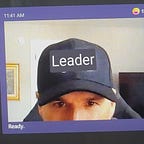Evaluating Your Leadership Orientation
I experience leadership as…
Please answer yes, no or sometimes for each statement.
It’s best if you do this without thinking, judging or evaluating. Just go with the first thought that comes into your mind.
/ a problem to solve.
/ a calling to live.
/ a challenge to meet.
/ a goal to achieve.
/ a story to tell.
/ a role to play.
/ a job to complete.
/ a burden to bear.
/ a mission to accomplish.
/ a purpose to embrace.
/ a means to an end.
/ a journey to experience.
/ a tool to apply.
/ a path to fulfillment.
/ a relationship to share.
/ a necessary evil.
/ a task to complete.
/ a mystery to explore.
/ a barrier to overcome.
/ a position to hold.
/ a prize to possess.
/ a means to survive.
/ a skill to master.
/ a promise to keep.
/ a power to wield.
Other: (insert additional answers here)
If this were a test of some sort I would tell you that your responses mean something and give you a handy label you can use to describe your leadership orientation during important, impression-making conversations around the office.
But his isn’t some sort of test.
I have no clue what your responses are or what they mean.
But maybe you do.
And I think that matters. A lot.
Your leadership orientation influences everything you do.
How you see people.
And problems.
Ways you respond to both.
How you view time.
And priorities.
Where you apply your energy.
Your orientation influences how you feel about things that happen as you lead. How you feel suggests how you should react. And this mostly happens without you even thinking about it.
Things are just happening.
You are deciding what they mean.
Almost instantly.
For example, if you said yes to experiencing leadership as “a goal to achieve” that sounds pretty good, right? But how might you instinctively respond when someone keeps moving the target? In a start-up where the priorities can change every hour, this could be a difficult orientation to manage.
I’m not implying that any answer is wrong or hurtful, but I am a suggesting that it’s helpful to recognize your unspoken beliefs and consider how they work (or don’t work) for your leadership. Some of the statements that sound good might actually be limiting you in unexpected ways.
It can also be helpful to look at where or when you took these beliefs onboard and formed your orientation.
Did you create an orientation toward leadership that fits who you are and how you want to be in the world or are you still mostly operating from an orientation someone else recommended or that you observed?
Did you take on these views because of events that happened in the past or to solve or prevent problems that no longer exist?
How would others finish this sentence if we asked them to do so with you in mind? Would they see what you believe?
If you’ve wondered why you keep finding yourself in certain situations, behaving in unhealthy ways or stuck in negative emotions, it might be that you are operating from an orientation that no longer works or doesn’t fit your current situation.
You won’t change what you won’t see. Self-awareness requires effort and it is a critical part of becoming a healthy and effective leader. Make time to revisit and realign your leadership orientation regularly as part of your ongoing personal growth and development.
Note: The optimal way to use this sentence completion exercise is to simply start with a sentence stem like the one above (in the title) and write as many completions to the stem as fast as possible without judging or evaluating. You’ll gain valuable insight into the beliefs that are operating just below the surface.
Wife: Why do you blog?
Me: I’m trying to make the world a better workplace.
Wife: You sound like a Ted Talk
Me: Perfect.
Thanks for checking out my post. Let’s do this better workplace thing. I value your feedback, claps, high-fives, hard questions, etc. I’m also seen hanging out on Twitter and LinkedIn.
